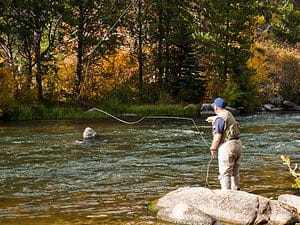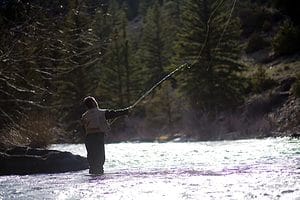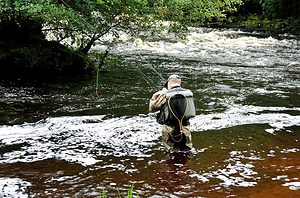Disclosure: Some posts contain affiliate links, which earn us a commission if you make a purchase through them. Positive Fishing © participates in various affiliate networks including the Amazon Services LLC Associates Program.
When you approach a river, and the water is ripping downstream, put a smile on your face. The fast pace doesn’t mean you’ll struggle to land fish. In fact, you may have more success when you fish in faster-moving water!
Fly anglers know the “itch” that comes in late May and June. It’s been a long winter, and fishing has been slow. The fish haven’t been extremely active, which can be hard to find due to the water level. After a while, fly anglers cannot help but hit the water. Odds are, however, the water is moving fast, and fly fishing can be a challenge.
Too many anglers see fast-moving water near 2000 cubic feet per second (CFS) and turn around. This flow of water is intimidating. It looks way too fast to even try, and you can’t imagine how you could land a fish. But you can fish in this extreme water!
In this article, I will take you through my five top tips for catching more fish in this challenging environment.
What To Look For In Fast-Moving Water?

When you approach the river or stream, you don’t have to be as careful about your noise level. The roar of the water will cover the noise of anything that you do as you wander along the bank. Feel free to explore and see what the river is going to provide.
The first thing to look for when fly fishing is any sort of slack water. You may approach and see white water as far as you can look up or downstream. It’s rarely the case that the water is all white. If it’s early in the runoff season, this might be the case, but stay patient and see what you can find.
The portions of slack water don’t have to be huge. A small cut bank or a wider portion of the river may provide some relief for the fish. That’s exactly what fish want!
A small portion of slack water that doesn’t completely drain them as they’re waiting to feed. Even a piece of pocket water behind a large rock is good enough for fish. They don’t need much, but they do need something to give them a break.
The next thing to look for is any sort of rises or insect hatches. Pay attention to the surface just like you would on a slack body of water. Fish will still continue to feed and even completely leave the water in pursuit of an insect. This could happen in white water!
The final thing to look for is rapids. Rapids will always have a slack portion of water at the end or off to the sides of it. Fish will sit off to the sides and wait for food to fall out of the rapids and pounce. The slower-moving water near the rapids is a gold mine.
How To Cast Flies In Fast-Moving Water?

Once you’ve found the fishable water, the next step is figuring out how to cast accurately into it. In fast-moving water, you’re not going to be able to make the very long casts you might be able to during the slower portions of the year. You’ll have to cast over fast-moving water and lose your ideal drift.
The best thing you can do is get as close to the slack water as possible. This will allow you to make an accurate cast and have a longer drift time. Once you’re as close as possible, give your fly extra time to get where it needs to go. Since water is moving fast, you won’t have as much room for error. Casting your fly in fast water means being more particular and precise with your casts.
Cast your fly upstream a bit further than you normally would, and then give it time to get into the “fish zone.” It’s not an easy task, but the more you do it, the more you’ll learn how precise you need to be.
Don’t go for the hero cast in fast-moving water. Your line will get pulled downstream, and you could even lose your fly. Keep it simple and focus on the areas where there are fish. You’re actually making your life easier in fast water! There are only so many places where these fish can hide.
You can either swing, or dead drift flies through fast-moving water. The least can go wrong with these methods! Be quick to mend and adjust your fly if necessary! Again, your “strike time” is low, so you want it to be as perfect as possible.
What Flies to Throw in Faster Moving Water?
Many anglers will only bother to throw streamers when the water is quickly flowing downstream. These flies let you quickly get into the fishy water, and you can land one of the trophy fish lurking nearby. Throwing streamers in quick water can be a challenge. You’ll struggle to make the proper cast, get hung up, and accomplish a natural-looking drift.
You can also throw dry dropper rigs in fast-moving water. If it’s a particular hatch, fish will still feast on top. The pace of the water doesn’t deter them. Find the slack portions, throw your dry dropper and see what you can find. For your dry, you’ll want a pretty large one. You can identify it easier, and it also allows you to drop a bigger nymph below it. A size 2 or 4 dry fly and a size 10 or 12 nymph will work just fine!
What Gear To Use In Faster Moving Water?
You don’t necessarily have to use “bigger” gear in faster-moving water. If you’re fishing a true European or Western United States river, you’ll want to use a five or six-weight rod regardless of the flow levels! The rod and reel weight doesn’t change, but your fly line and leader can!
If you’re streamer fishing, you’ll want to use a sink tip line. Since you don’t have a chance for your fly to get low in the water column, you want as much help as possible. A sink tip line will get you low and where the fish are hiding!
Also, don’t be afraid to use a heavy leader regardless of the flies you’re using. You want a chance to move your fly quite quickly and not have to worry about the fast-moving water tangling your fly and getting in the way.
What To Avoid In Fast-Moving Water?

The first thing you should avoid is wading. Wading in fast-moving water can be extremely dangerous! Be extra careful, and don’t be afraid to use a wading staff if the water moves at a really good pace.
The next thing to avoid is trying to be the hero and make a miraculous catch. If the water you’re trying to fish has a section of rapids between you and the area that you are fishing, maybe choose a different section. Rapids are dangerous, not only the current but also the uneven river bed where stones and rocks are slippery.
Final Thoughts
When you’re fishing in fast-moving water, keep it simple. Don’t overcomplicate things, and try to do too much. You’ll find yourself trying to make more casts than drifts. Hunker down in a section and fish it. If it’s slower than the water around it, odds are you’ll find fish.
I really hope you enjoyed reading this article on fly fishing in fast-moving waters. You can read more about this topic in my spin fishing fast-moving rivers article!
- Wading Belt Essentials: Ensuring Safer Fishing - January 9, 2024
- Fishing For Catfish (Top Tips, Bait, & Gear To Catch The Big 3) - October 20, 2022
- Fishing Line Strength Vs. Diameter Chart: Why Is It Important? - October 12, 2022

